Will someone explain to me the differences among these? From my looking the yards may have one or more of them and they all seem to do the same thing. Puzzled (as usual  )
)
-

Win a Free Custom Engraved Brass Coin!!!
As a way to introduce our brass coins to the community, we will raffle off a free coin during the month of August. Follow link ABOVE for instructions for entering.
You are using an out of date browser. It may not display this or other websites correctly.
You should upgrade or use an alternative browser.
You should upgrade or use an alternative browser.
- Joined
- Aug 8, 2019
- Messages
- 5,461
- Points
- 738

A jeer is to hoist things, like the sails and Yards. Think about buntlines and stuff like that. Running rigging.
A sling is something you use to wrap around a box for example to attach the jeer to it, so you can hoist it. It can also hang around the masttop the attach the side tackle to it.
A tie is a piece of rope on your sail where you can tie the sail up (reefing of the sails) but also to tie the end of the rope to secure it to unravel.
I hope I explained it right, I find your question a little strange, because these things explain themselves mostly with the drawing or text around it. Maybe someone with English native language can explain it better.
A sling is something you use to wrap around a box for example to attach the jeer to it, so you can hoist it. It can also hang around the masttop the attach the side tackle to it.
A tie is a piece of rope on your sail where you can tie the sail up (reefing of the sails) but also to tie the end of the rope to secure it to unravel.
I hope I explained it right, I find your question a little strange, because these things explain themselves mostly with the drawing or text around it. Maybe someone with English native language can explain it better.
Hi Steel,A tie is a piece of rope on your sail where you can tie the sail up (reefing of the sails)
Could you please post a drawing of this? What you describe sounds like reef points or harbour gaskets but it would be interesting to see pictures of sail ties if they are different items. The only things I can find on ties have nothing to do with sails, but rather yards. The following are drawings from Lees' Masting and Rigging English Ships of War for lower yard and topsail yard ties. In addition to the pictures he describes the topgallant yard ties which are also attached to the yards, not the sails. In the case of the topgallant yard it was a line hitched around the yard, taken through a sheave in the top of the topgallant mast and taken down towards the lower top. The ties varied with era but from what I could research they were never attached to sails.
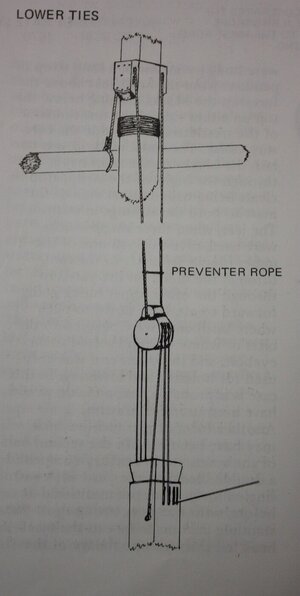
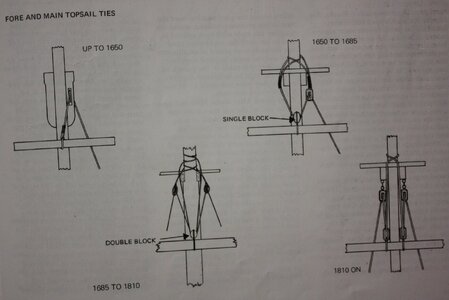
Hi Don,
These are best explained by James Lees and probably others depending on the era. Depending on the era the yards had either ties or jeers, not both but they served the same purpose and there were some similarities depending on era and which yard was involved. Slings were also present depending on the era as well. Slings were not used until about 1773 as an addition to jeers. To make it more interesting when slings were in use they were rope unless in wartime at which time they would be made of chain. They were chain in peacetime and wartime after about 1840. There are a number of pages as Lees goes into the ties and jeers as well as slings for the various yards in various eras over many pages. I hesitate to take pictures of that many pages as it is copyrighted material. Anyone interested in rigging British RN ships, as you are, would be well served to have a copy of this book. Jeers of the lower yard for a few eras is below as well as slings. Again these are from James Lees' The Masting and Rigging of English Ships of War
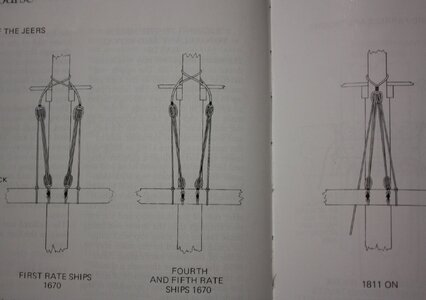
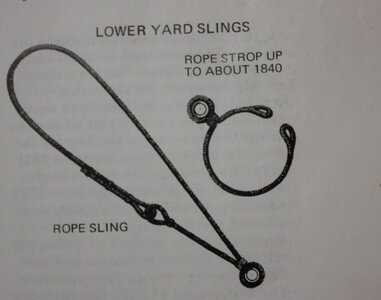
If the moderators feel this is too much copyrighted information from Lees' book in the post, please remove them or let me know and I will delete them from the post.
Many thanks
Allan
Last edited:
I am also confused. Why we need a SLING and JEERS. They both serve same function and are on same yard. Sling is of a permanent length so it is not adjustable. Jeers is a sling with blocks. Could some one please explain?
Looking at pictures above is true for a lower mast yard. On top mast yard the jeers is called a TYE. They do not have a SLING on top mast yard. WHY is sling present on low mast yard and is not present on top mast yard? Yet another mystery.
Looking at pictures above is true for a lower mast yard. On top mast yard the jeers is called a TYE. They do not have a SLING on top mast yard. WHY is sling present on low mast yard and is not present on top mast yard? Yet another mystery.
Last edited:
I have Lees book and while it is an excellent source it is like all the others. It tells you where the rope goes but it doesn't tell you what it does. At least not that I can find  . What I was after is the same as YT's post, why so many many things holding the yard on. I've been thinking that maybe "jeers" just refers to the rope. In Dan Vadas' "Vulture" build he has what he calls "jeer tyes" and they are just the blocks and the tyes
. What I was after is the same as YT's post, why so many many things holding the yard on. I've been thinking that maybe "jeers" just refers to the rope. In Dan Vadas' "Vulture" build he has what he calls "jeer tyes" and they are just the blocks and the tyes
I've just been getting confused about the whole thing and thought maybe an explanation of how they worked together may clear my head.
I've just been getting confused about the whole thing and thought maybe an explanation of how they worked together may clear my head.
Exactly! All books I have are like this. I guess we have to figure it out on our own. My guess is the jeers on lower mast are for lowering and raising the lower mast yard. The sling on same yard is a redundant safety feature if jeers brake down. On top mast yard they have only the TYE rope with block which is same as jeers for lowering and raising the yard but they did not bother here with safety as much as this yard is not that heavy and important as a lower mast yard. So they had no redundant safety as a SLING on lower yard.Lees book and while it is an excellent source it is like all the others. It tells you where the rope goes but it doesn't tell you what it does.
With respect to the hoisting of the yard aloft, jeers or a halyard/tie are used to get it there, and slings are there to guarantee that it stays there. Let's say you want to work underneath your car and fix the exhaust system. The hydraulic lift is used to raise it so you can get underneath it, but the jackstands are there to make sure it stays up there and doesn't fall on you if the lift fails. You want both.I am also confused. Why we need a SLING and JEERS. They both serve same function and are on same yard. Sling is of a permanent length so it is not adjustable. Jeers is a sling with blocks. Could some one please explain?
Looking at pictures above is true for a lower mast yard. On top mast yard the jeers is called a TYE. They do not have a SLING on top mast yard. WHY is sling present on low mast yard and is not present on top mast yard? Yet another mystery.
Thanks. Do you know why only lower mast yard has a sling but upper yards don’t?, and slings are there to guarantee that it stays there.
Probably because they are much lighter and easier to handle using manpower. The course yards are REALLY heavy.Thanks. Do you know why only lower mast yard has a sling but upper yards don’t?
- Joined
- Aug 8, 2019
- Messages
- 5,461
- Points
- 738

The problem is the year you talking about. 18th and 19th century. Is very different to earlier ages. Especially in Dutch language. I don't understand the English name tie. For me a tie is like a piece of rope used to make a knot and secure it. Like reefbands.
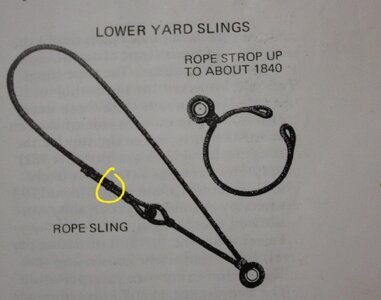
Or something like I marked. You have also the plastic thing called tie-wrap.
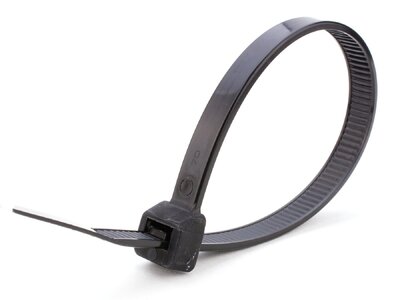
But Learning again something. A tie kan be the same thing as halyard to lower and hoist a mast.
Slings ans jeers I know, Kurt describe them perfect with the car to understand the difference.
Names in rigging can confuse sometimes.

Or something like I marked. You have also the plastic thing called tie-wrap.

But Learning again something. A tie kan be the same thing as halyard to lower and hoist a mast.
Slings ans jeers I know, Kurt describe them perfect with the car to understand the difference.
Names in rigging can confuse sometimes.
I understand your confusion. The word tie in English can mean different things depending on the context. In the case I was using above, a method of hoisting a yardarm used in earlier continental European ships was the tie and halyard. The tie is the line from the yardarm over masthead and down to the upper block of the tackle below. In some ships, the ties went through sheaves in the mast just below the top, as in the example below. The halyard is the line in the tackle, which is secured to the timberhead. On the course sail yards, there are two ties. On lighter yards up higher and on the lateen yard, there is one.The problem is the year you talking about. 18th and 19th century. Is very different to earlier ages. Especially in Dutch language. I don't understand the English name tie. For me a tie is like a piece of rope used to make a knot and secure it. Like reefbands.
View attachment 456906
Or something like I marked. You have also the plastic thing called tie-wrap.
View attachment 456907
But Learning again something. A tie kan be the same thing as halyard to lower and hoist a mast.
Slings ans jeers I know, Kurt describe them perfect with the car to understand the difference.
Names in rigging can confuse sometimes.

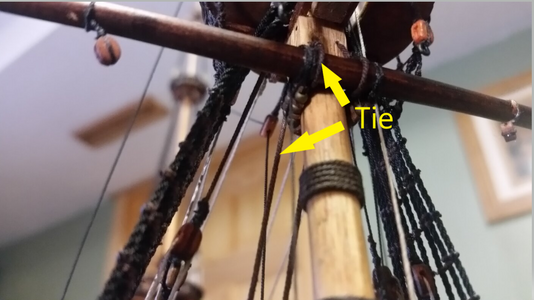
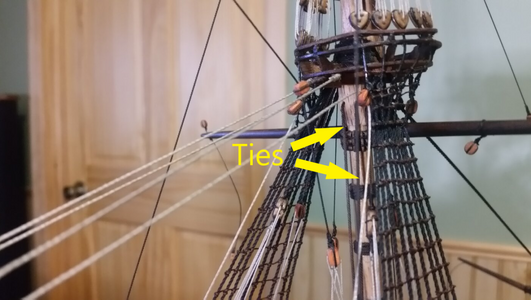
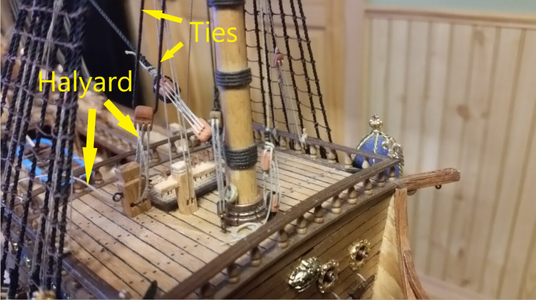
Great explanation. Also, keep in mind that the sling was made of rope when at peace. In the event of war/battles these were replaced with chain to reduce the likelihood that the sling could be shot away. I believe it was about 1870 that all slings were chain, not rope.With respect to the hoisting of the yard aloft, jeers or a halyard/tie are used to get it there, and slings are there to guarantee that it stays there.
Great question. Just a guess to add to the conversation as to why...... the topsail yards, top gallant yards and royals were lowered at times when in port. If there were slings, they would have to be unrigged. Then again I found this reference to slings in Steel's The Elements and Practice of Rigging on page 204:Do you know why only lower mast yard has a sling but upper yards don’t?
TOPSAIL-YARDS.
THE TOP ROPE is fastened to the slings of the yard, and stopt from thence to the yard-arm, by which it is hove on-board, and placed for rigging as follows.Allan
Just to reinforce the above point as to why no slings on the topsail & topgallant yards. In addition to being lowered in port, these yards were often lowered in bad weather to facilitate reefing the sales. The below images are from John Harland's book Seamanship in the Age of Sail, which is an amazing reference for how all the activities were done on a ship. For example, there are 30 pages to cover making/shortening sail and reefing, so quite thorough.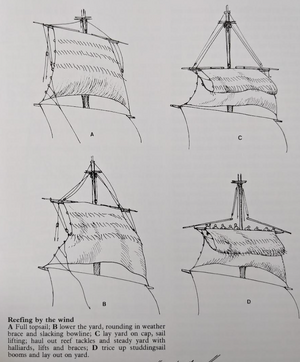
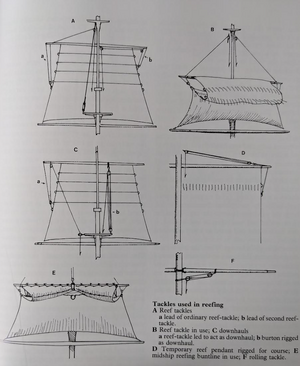


Do you recommend using neutral or tan lines for running rigging?






